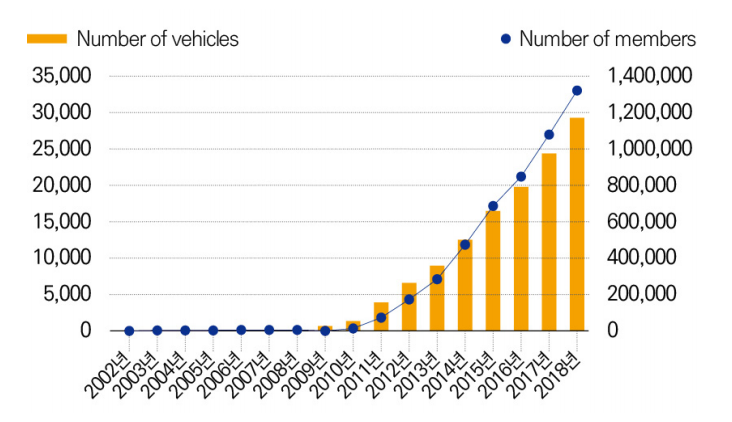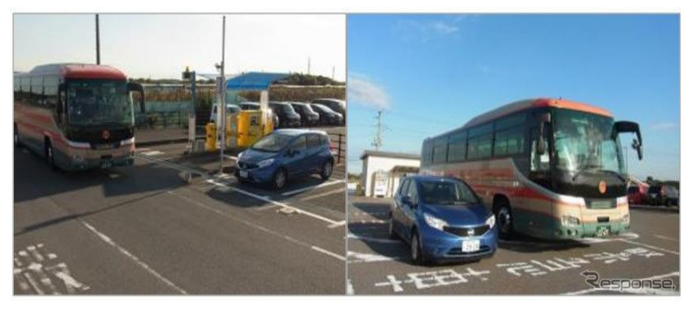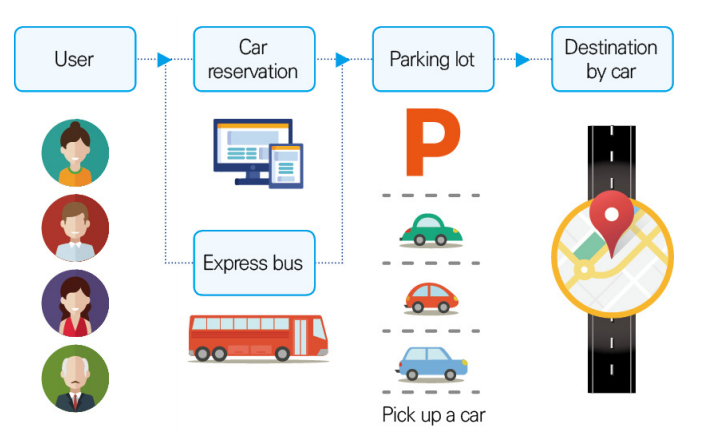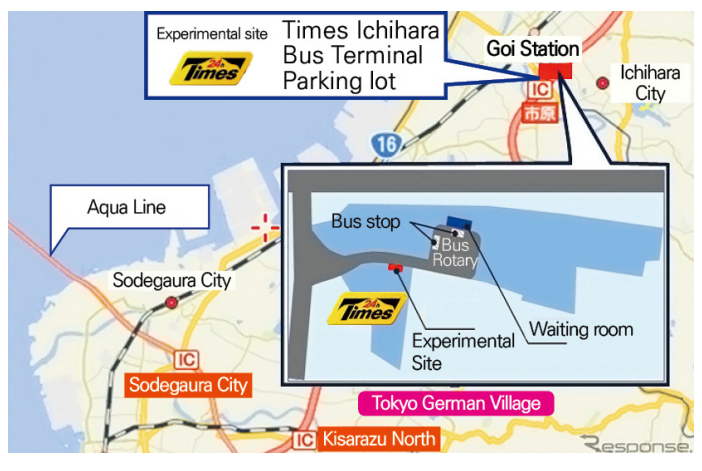List
Story > NEWS > Detail
[Resources] Car-sharing of Japan
In the form of sharing vehicles without owning them individually, the car is reserved and used only when necessary in a complex downtown area, and is generally operated under a member system subscribed to the service. In the case of Japan, outstanding new concept vehicle operation method was introduced actively in terms of efficiency as well as solving extreme traffic and parking difficulties in downtown areas, while car-sharing system was highlighted and expanded around downtown Japan. This creates synergy among disparate industries such as automobiles, platforms, IT and finance.
Since the car-sharing business was first introduced in Japan in 1999 and the commercialization began in earnest in 2002, various business models and joint projects have been applied to promote car-sharing, and a business type linked to the car-sharing business, local governments and railway operators and ferry operators has been gradually developed among the concerned businesses. In particular, efforts are being made to incorporate car-sharing as part of the public-private consultative body, the introduction and establishment of a road map, as well as the establishment of a public-private consultative body, to promote understanding and promotion of customers' use of car-sharing. To increase operational efficiency, the company is expanding its business by other means of mobility by reviewing its affiliate base and specific stations. It is also working on strategies such as providing active public incentives through business tie-ups between public institutions and car-sharing private operators.
In the case of Japan's car-sharing Japan, the development of high land prices and public transportation has led to the development of facility-based car-sharing similar to Europe rather than road-based car-sharing. This does not mean setting up a foothold on a regular road, but rather a handful of hubs in a joint housing complex, convenience store or subway history, and deploying 1-2 car-sharing vehicles here. Therefore, unlike Korea, most residential areas, not apartment complexes, are operated as unmanned parking lots. It is also predicted that the car-sharing market in Japan has grown and expanded rapidly due to the environment in which smartphones have made vehicle searches and reservations simple. As shown in Table 1 in March 2018, the number of car-sharing vehicle stations in Japan has increased by a total of 14,941 locations nationwide (a 16 percent increase from the previous year), the number of vehicles has increased by 29,208 (a 19 percent increase from the previous year), and the number of members has increased by 1,320,947 (22 percent compared to the previous year).

In Japan, high-speed buses and car-sharing Japan, a system of connected transport was established through connection with local governments as well as railways. In addition, the car-sharing business is actively carried out through the linkage between the car-sharing operator and the express bus operator. In particular, in the express bus sector, large express bus operators in Japan, including Cominato Railroad Corporation, are being developed in line with the purpose of promoting convenience of customers through car-sharing and establishing a low-environmental transportation system. Cominato Railroad Corporation and Times Car Plus (タイムズ24) participated in the Department of Land, Infrastructure and Transport's "Highway Bus and Car-sharing Social Experiment" from December 2016 to December 2017, as shown below. This social experiment provided a means of moving around the express bus station where the distribution was taking place and the secondary transportation after the express bus exit. Therefore, the possibility of promotion of tourism and revitalization of areas was verified as a result of the expansion of the right of action by the users of express buses. Specifically deployed vehicles were introduced at the Times Ichihara bus terminal parking lot in Ichihara City, Chiba Prefecture, adjacent to the express bus stop, with two small passenger cars from the car-sharing service Times Car Plus.

Following the social experiment, the convenience of express bus and car-sharing is improved by the provision of vehicles around express bus stops, which will lead to the acquisition of new customers and the transport of customers by visiting tourist and leisure facilities in Ichihara city, and the promotion of tourism and revitalization of the region. Therefore, vehicle placement at major stations, airports and ports of railways was actively carried out, as shown in Figure 3 and Figure 4 below. In addition, we have been pushing for the connection to be used as a secondary transport for the period. Through this cooperation with the express bus, we realized the connection with the new period of transportation.


In addition, car-sharing services are expanding further. Among Toyota's leading projects is the Ha:mo RIDE. The move is aimed at establishing a next-generation transportation system in earnest, and currently operates in Thailand's Bangkok as well as in Japan, including Toyota City in Aichi Prefecture, Tokyo and Okinawa. Using 'society with high mobility', 'Clean society' and 'regional revitalization' as their motto, they pursued a micro-sharing network. The service was provided with relatively simple service that can be used through operation of a Smartphone. Accessibility from public transport agencies was also easy, so ultra-small electric cars were used that were free of stress to users and could be used simply for very short distances. Moreover, performance vs. price ratio was also evaluated to be excellent because it is available as much as much As mentioned earlier, there was no environmental pollution burden to use electric cars, and it also helped save energy. Finally, as tablet can search for recommended routes in self-developed applications, utilization has also been very high in tourist destinations. As such, car-sharing, a shared economy, is a good example of how it is evolving into a compact and personalized one.
In the form of sharing vehicles without owning them individually, the car is reserved and used only when necessary in a complex downtown area, and is generally operated under a member system subscribed to the service. In the case of Japan, outstanding new concept vehicle operation method was introduced actively in terms of efficiency as well as solving extreme traffic and parking difficulties in downtown areas, while car-sharing system was highlighted and expanded around downtown Japan. This creates synergy among disparate industries such as automobiles, platforms, IT and finance.
Since the car-sharing business was first introduced in Japan in 1999 and the commercialization began in earnest in 2002, various business models and joint projects have been applied to promote car-sharing, and a business type linked to the car-sharing business, local governments and railway operators and ferry operators has been gradually developed among the concerned businesses. In particular, efforts are being made to incorporate car-sharing as part of the public-private consultative body, the introduction and establishment of a road map, as well as the establishment of a public-private consultative body, to promote understanding and promotion of customers' use of car-sharing. To increase operational efficiency, the company is expanding its business by other means of mobility by reviewing its affiliate base and specific stations. It is also working on strategies such as providing active public incentives through business tie-ups between public institutions and car-sharing private operators.
In the case of Japan's car-sharing Japan, the development of high land prices and public transportation has led to the development of facility-based car-sharing similar to Europe rather than road-based car-sharing. This does not mean setting up a foothold on a regular road, but rather a handful of hubs in a joint housing complex, convenience store or subway history, and deploying 1-2 car-sharing vehicles here. Therefore, unlike Korea, most residential areas, not apartment complexes, are operated as unmanned parking lots. It is also predicted that the car-sharing market in Japan has grown and expanded rapidly due to the environment in which smartphones have made vehicle searches and reservations simple. As shown in Table 1 in March 2018, the number of car-sharing vehicle stations in Japan has increased by a total of 14,941 locations nationwide (a 16 percent increase from the previous year), the number of vehicles has increased by 29,208 (a 19 percent increase from the previous year), and the number of members has increased by 1,320,947 (22 percent compared to the previous year).

In Japan, high-speed buses and car-sharing Japan, a system of connected transport was established through connection with local governments as well as railways. In addition, the car-sharing business is actively carried out through the linkage between the car-sharing operator and the express bus operator. In particular, in the express bus sector, large express bus operators in Japan, including Cominato Railroad Corporation, are being developed in line with the purpose of promoting convenience of customers through car-sharing and establishing a low-environmental transportation system. Cominato Railroad Corporation and Times Car Plus (タイムズ24) participated in the Department of Land, Infrastructure and Transport's "Highway Bus and Car-sharing Social Experiment" from December 2016 to December 2017, as shown below. This social experiment provided a means of moving around the express bus station where the distribution was taking place and the secondary transportation after the express bus exit. Therefore, the possibility of promotion of tourism and revitalization of areas was verified as a result of the expansion of the right of action by the users of express buses. Specifically deployed vehicles were introduced at the Times Ichihara bus terminal parking lot in Ichihara City, Chiba Prefecture, adjacent to the express bus stop, with two small passenger cars from the car-sharing service Times Car Plus.

Following the social experiment, the convenience of express bus and car-sharing is improved by the provision of vehicles around express bus stops, which will lead to the acquisition of new customers and the transport of customers by visiting tourist and leisure facilities in Ichihara city, and the promotion of tourism and revitalization of the region. Therefore, vehicle placement at major stations, airports and ports of railways was actively carried out, as shown in Figure 3 and Figure 4 below. In addition, we have been pushing for the connection to be used as a secondary transport for the period. Through this cooperation with the express bus, we realized the connection with the new period of transportation.


In addition, car-sharing services are expanding further. Among Toyota's leading projects is the Ha:mo RIDE. The move is aimed at establishing a next-generation transportation system in earnest, and currently operates in Thailand's Bangkok as well as in Japan, including Toyota City in Aichi Prefecture, Tokyo and Okinawa. Using 'society with high mobility', 'Clean society' and 'regional revitalization' as their motto, they pursued a micro-sharing network. The service was provided with relatively simple service that can be used through operation of a Smartphone. Accessibility from public transport agencies was also easy, so ultra-small electric cars were used that were free of stress to users and could be used simply for very short distances. Moreover, performance vs. price ratio was also evaluated to be excellent because it is available as much as much As mentioned earlier, there was no environmental pollution burden to use electric cars, and it also helped save energy. Finally, as tablet can search for recommended routes in self-developed applications, utilization has also been very high in tourist destinations. As such, car-sharing, a shared economy, is a good example of how it is evolving into a compact and personalized one.



